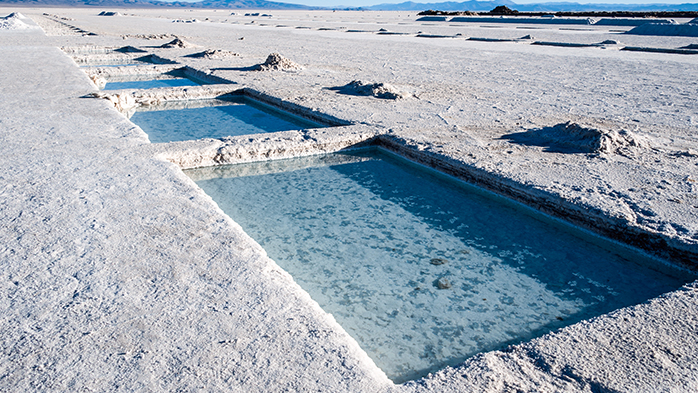Despite having the largest lithium resource globally, Bolivia has struggled to develop its lithium industry. Political, social and environmental obstacles have blocked the growth of lithium mining in Bolivia. However, the South American country is now looking to a Chinese consortium to overcome these hurdles and catch up with its neighbours.
Can CBC succeed where others failed?
In June 2023 Bolivian president, Luis Acre, confirmed a $1.4 bn investment from a Chinese consortium, led by Contemporary Amperex Technology Co (CATL) to develop Bolivia’s lithium resources.
The president announced that the consortium will construct two lithium plants, which will use direct lithium extraction (DLE) technology, on the Uyuni and Coipasa salt flats, also known as salars. Bolivian state-owned mining company, Yacimientos de Litio Bolivianos (YLB), will own 51% of the project, with the remaining share split between the consortium members. Upon completion, each plant will have a nameplate capacity of 25,000 t/y lithium carbonate.
The consortium, named CBC, includes CATL, CMOC Group, and Brunp Recycling and was chosen to partner with YLB in January 2023.
Early in 2024, YLB announced a tender to create strategic cooperation with international companies. The scope of work includes technical and financial viability of exploitation for seven salars – Uyuni, Coipasa, Pastos Grandes, Capina, Cañapa, Chiguana and Empexa.
Bolivia’s previous struggles with foreign investment
Although the CBC-YLB deal is certainly a welcome sign for Bolivia’s underutilised lithium resources, it remains to be seen whether the project will be a success given the industry’s past record.
One of the largest obstacles has been Bolivia’s relationship with foreign investors. Bolivia ranked 70th out of 84 countries in 2022 for investment attractiveness by the Fraser Institute, significantly lower than Chile, and the lowest ranking of any country in the Americas.
Bolivia’s lithium troubles go as far back as the 1990’s when FMC Lithium, now Arcadium Lithium, pulled out of a $92 M deal to develop the Uyuni salt flat following public protests. FMC opted to seek other opportunities in Argentina where taxes were lower, there was less public hostility, and the contract length was more agreeable.
In 2008, former president Evo Morales nationalised Bolivia’s lithium resources, aiming to prevent foreign investors from exploiting the country’s resources. In 2017, Law 927 was signed, creating YLB as the only company responsible for developing all Bolivian salars, covering the extraction of brines through to the refining of lithium carbonate and lithium hydroxide.
In 2018, YLB formed a joint venture with a German company called ACI Systems Alemania (ACISA) to develop the Uyuni salt flat and build a lithium hydroxide plant. However, by November 2019 the Bolivian government annulled the deal, after attempts to increase the royalty agreement from 3% to 11% were unsuccessful, and local protests ensued.
In February 2019, YLB signed a deal with another Chinese consortium led by Xinjiang TBEA Group, to develop the Coipasa and Pastos Grandes salars. However, the deal fell through amid the political turmoil that followed President Morales’ resignation.
There is currently a 15,000 t/y lithium carbonate production facility at Llipi, south of Uyuni, increasing its capacity. The plant became operational in December 2023 and will produce 3 kt LCE in 2024, according to YLB. However, market participants have indicated that YLB is struggling to ramp up production. A pilot plant is also reportedly operational although it will produce no more than 1 kt LCE in 2024.
What is restricting the world’s largest lithium resource?
Despite the country’s past problems, it is unsurprising that foreign investors continue to return given Bolivia’s rich lithium resources. The US Geological Survey estimates that Bolivia has 23 Mt of lithium resources in the Uyuni Salar alone. Based on this, Bolivia has the largest lithium resource globally, despite other salars not being included in this resource estimate. Research at other Bolivian salars has not been made public, or research is yet to be conducted. In 2018, when the resource estimate was 21 Mt, YLB announced that only 2 Mt of the lithium resource were classified as measured or indicated and 19 Mt as inferred.
Despite the sizeable resource, when comparing Bolivia’s lithium industry to its partners in the “Lithium Triangle” it lags far behind Chile and Argentina in terms of output.

Chile has managed to industrialise its lithium resources, producing over 25% of global supply in 2023. Argentina's lithium industry is developing rapidly, too, expected to quadruple its production in the next two years.
However, another major hurdle for Bolivia to overcome is the magnesium to lithium ratios in Bolivian brines. At the Uyuni Salar, ratios of greater than 21:1 have been reported, compared to 6:1 in Argentina. Given the similar chemical properties between lithium and magnesium ions, separation is a difficult process, and high ratios increase costs significantly.
Despite this, the Chinese consortium is well qualified to deal with this issue, as DLE has been used in Qinghai since 2014 and in Tibet since 2015 to extract brine with magnesium to lithium ratios in excess of 300:1. Similarly, DLE has been used for some processing at Arcadium’s Salar de Hombre Muerto project in Argentina to lower production costs.

The environmental impact must be considered
Environmental issues are another major obstacle to developing Bolivia’s lithium resources. Although seasonal complications at high altitudes in Bolivia are not as significant a problem as in western China, they still create difficulties. Delivering consumables to the sites and exporting finished products is certainly made difficult by high altitude but a lack of developed infrastructure hinders this even further.
Water scarcity in the region is also a major issue. While freshwater consumption using evaporation ponds at Salar de Atacama and Olaroz was reported at 22.5m³ and 50m³ per tonne respectively, Livent reported that consumption at its Salar de Hombre Muerto DLE plant was almost 70m³ per tonne in 2022. If DLE consumes more water than evaporation ponds, it poses a serious threat to the local environment.
Promising signs but a long road ahead
Considering Bolivia’s issues with foreign investment, its high magnesium to lithium ratios, and environmental barriers, the South American country is a risky location to invest in lithium production. Despite this, CBC is confident that it can bring two lithium carbonate plants online. The Chinese consortium is well placed to succeed in the region for several reasons. The current use of DLE in western China’s high magnesium to lithium ratio brines will help them overcome similar issues in Bolivia.
Furthermore, the consortium will be led by CATL, the largest cell manufacturer globally, suggesting significant amounts of capital should be available to help bring the projects into production.
Finally, the Bolivian government is aligned more closely with China than the West – the strongest example of this is that Bolivia now conducts its foreign trade in Chinese Yuan. The upshot of this is that the Chinese consortium will be received more favourably than most foreign investors. The two countries are politically close and have previously collaborated on mining in Bolivia in sectors such as tin.
Although these factors will be encouraging for CBC, it is important to understand that success is still a long way off. CBC is attempting to set a precedent in Bolivia but many of the issues which have plagued previous attempts to develop the country’s resources still exist, and will have to be overcome by the consortium if it is to succeed.
Explore this topic with CRU





